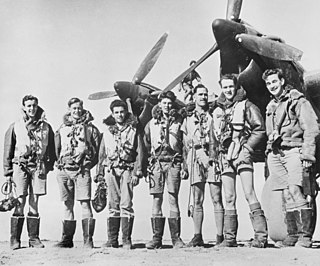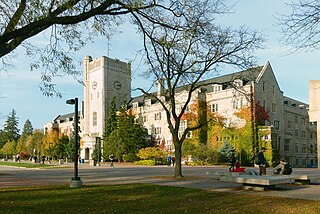Related Research Articles

The Desert Air Force (DAF), also known chronologically as Air Headquarters Western Desert, Air Headquarters Libya, the Western Desert Air Force, and the First Tactical Air Force (1TAF), was an Allied tactical air force created from No. 204 Group RAF under RAF Middle East Command in North Africa in 1941 to provide close air support to the British Eighth Army against Axis forces. Throughout the Second World War, the DAF was made up of squadrons from the Royal Air Force (RAF), the South African Air Force (SAAF), the Royal Australian Air Force (RAAF), the United States Army Air Forces (USAAF) and other Allied air forces.
RAF Ferry Command was the secretive Royal Air Force command formed on 20 July 1941 to ferry urgently needed aircraft from their place of manufacture in the United States and Canada, to the front line operational units in Britain, Europe, North Africa and the Middle East during the Second World War.
Canadian Forces Station Debert was a Canadian Forces station located in Debert, Nova Scotia. It was most recently used during the Cold War as a communications facility and was home to a "Regional Emergency Government Headquarters" (REGH) complex, more commonly known by their nickname "Diefenbunker."
No. 5 Group was a Royal Air Force bomber group of the Second World War, led during the latter part by AVM Sir Ralph Cochrane.

No. 2 Group is a group of the Royal Air Force which was first activated in 1918, served from 1918–20, from 1936 through the Second World War to 1947, from 1948 to 1958, from 1993 to 1996, was reactivated in 2000, and is today part of Air Command.

438 "City of Montreal" Tactical Helicopter Squadron is a unit of the Royal Canadian Air Force. The squadron operates the CH-146 Griffon tactical helicopter from the Hartland de Montarville Molson Hangar of CFB St. Hubert in Quebec, Canada. Its tasks include armed and unarmed tactical utility transport, training aircrew personnel in basic and advanced aviation tactics, technical training of groundcrew personnel and flight engineers and the periodic maintenance of CH-146 fleet aircraft. They also include as residual capabilities search and rescue, reconnaissance and support to federal, provincial and local law enforcement agencies. A "total force" unit composed of members of the Regular Force, and both full time and part time reservists, the squadron is part of 1 Wing at CFB Kingston Ontario.

Article XV squadrons were Australian, Canadian, and New Zealand air force squadrons formed from graduates of the British Commonwealth Air Training Plan (1939) during World War II.

No. 428 Squadron RCAF, also known as 428 Bomber Squadron, and 428 Ghost Squadron, was first a night bomber squadron in the Royal Canadian Air Force engaged in strategic bombing during World War II, as based in Yorkshire. At the end of the war the squadron moved to Nova Scotia before being disbanded in September 1945. In 1954 the squadron was reformed as 428 All-Weather (Fighter) Squadron, before being again disbanded in 1961.

Air Marshal George Owen Johnson CB, MC was a Canadian aviator, World War I Flying Ace and a senior commander in the Royal Canadian Air Force during World War II.
No. 666 Squadron RCAF was originally an RCAF Air Observation Post (AOP) squadron formed during the Second World War. It was manned principally by Royal Canadian Artillery (RCA) and Royal Canadian Air Force (RCAF) personnel.

No. 401 Tactical Fighter Squadron, a.k.a. "City of Westmount" Squadron, is a Royal Canadian Air Force squadron based at CFB Cold Lake. During World War II it was a fighter squadron and is notable for having fought in the Battle of Britain. Postwar, the squadron operated in Canada as an auxiliary squadron, reserve squadron and a helicopter and training squadron. In 2015 it was reactivated as a Tactical Fighter Squadron.

Air Vice Marshal Henry Neilson Wrigley, CBE, DFC, AFC was a senior commander in the Royal Australian Air Force (RAAF). A pioneering flyer and aviation scholar, he piloted the first trans-Australia flight from Melbourne to Darwin in 1919, and afterwards laid the groundwork for the RAAF's air power doctrine. During World War I, Wrigley joined the Australian Flying Corps and saw combat with No. 3 Squadron on the Western Front, earning the Distinguished Flying Cross; he later commanded the unit and published a history of its wartime exploits. He was awarded the Air Force Cross for his 1919 cross-country flight.

No 211 Group or No. 211 Group was a Group of the Royal Air Force (RAF) formed on 10 December 1941 by renaming Nucleus Group Western Desert. The group was officially disbanded from 3 February 1942 to 12 March 1943, although some references refer to some of its original squadrons during this period as being with 211 Group. On 12 March 1943, the group reformed as No. 211 Group and Air Commodore Richard Atcherley assumed command of the group on 11 April 1943. At this time, 211 Group was the principle fighter force of the Desert Air Force (DAF) commanded by Air Vice Marshal Harry Broadhurst, and DAF was a sub-command of Air Marshal Sir Arthur Coningham's Northwest African Tactical Air Force (NATAF).
This article lists the order of battle of RAF Coastal Command throughout the Second World War in the European Theatre of World War II.

RAAF Overseas Headquarters was a Royal Australian Air Force (RAAF) administrative unit established in London during World War II.
No. 6 Squadron was a Royal Canadian Air Force squadron that was active during the Second World War.

RCAF Station Guelph was a Second World War British Commonwealth Air Training Plan (BCATP) station located in Guelph, Ontario on the campus of the Ontario Agricultural College (OAC), the Ontario Veterinary College (OVC), and the Macdonald Institute. The station is usually known as No. 4 Wireless School and was home to several schools as well as test facilities for air force kitchens.

Air Marshal Harold "Gus" Edwards, was a Canadian Air Force officer who played a prominent role in building the Royal Canadian Air Force (RCAF). From November 1941 to December 1943, Edwards served as Air Officer Commanding-in-Chief Overseas where he was responsible for all RCAF personnel. In June 2012, Edwards was posthumously inducted into Canada's Aviation Hall of Fame for his "outstanding leadership in building Canada's national air force".

Air Vice Marshal Leigh Forbes Stevenson, was a senior commander in the Royal Canadian Air Force during the Second World War. Early in the First World War he served in the trenches on the Western Front before becoming a pilot in the Royal Flying Corps. After the war he joined the fledgling Canadian Air Force. Stevenson remained in Air Force service when in 1924 the Royal Canadian Air Force was founded and served throughout the inter-war years.
No. 3 Training Command RCAF was a training command of the Royal Canadian Air Force during World War II established to administer the schools of the British Commonwealth Air Training Plan.
References
- ↑ THE R.C.A.F. OVERSEAS, THE FIRST FOUR YEARS, p. 35
- ↑ Milberry, Larry, ed. Sixty Years—The RCAF and CF Air Command 1924–1984. Toronto: Canav Books, 1984. ISBN 0-9690703-4-9. pg 130
- ↑ The Crucible of War, 1939-1945, Volume 3 Retrieved 1 December 2015